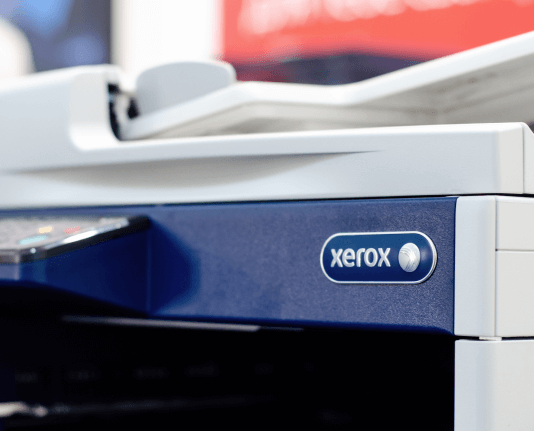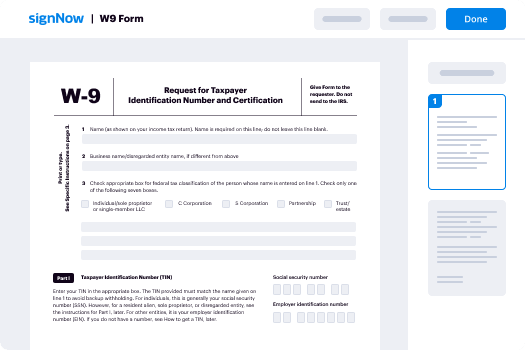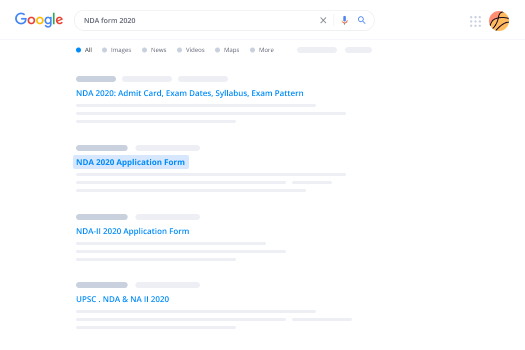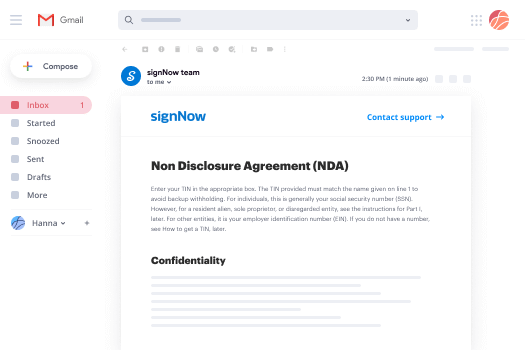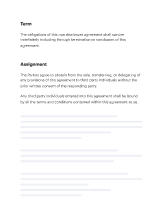Sign Presentation for Procurement Easy
Make the most out of your eSignature workflows with airSlate SignNow
Extensive suite of eSignature tools
Robust integration and API capabilities
Advanced security and compliance
Various collaboration tools
Enjoyable and stress-free signing experience
Extensive support
Keep your eSignature workflows on track
Our user reviews speak for themselves






Developing a compelling procurement presentation
In the current rapid business landscape, a compelling procurement presentation can greatly improve your organization's productivity. Utilizing tools such as airSlate SignNow allows you to optimize the signing process, guaranteeing that your documents are completed swiftly and securely. This guide will take you through the key steps to effectively leverage airSlate SignNow.
Procedures to craft your procurement presentation using airSlate SignNow
- Launch your chosen web browser and head to the airSlate SignNow homepage.
- If you are a first-time user, sign up for a complimentary trial; if you already possess an account, simply log in.
- Choose the document you intend to sign or prepare for signing and upload it to the site.
- To conserve time for later use, think about converting your document into a reusable template.
- Access your uploaded document and make any required modifications, such as incorporating fillable fields or inserting specific details.
- Add your signature to the document and designate signature fields for recipients needing to sign.
- Click 'Continue' to set up the eSignature invitation and send it out right away.
By adhering to these procedures, you can develop an effective procurement presentation that takes advantage of airSlate SignNow's features. The platform not only provides a comprehensive feature set for your investment but is also tailored for user-friendliness and scalability, making it perfect for small to medium-sized businesses.
Don’t let the chance to improve your document signing process pass you by. Begin your free trial with airSlate SignNow today and discover the impact it can have on your procurement presentations!
How it works
Rate your experience
-
Best ROI. Our customers achieve an average 7x ROI within the first six months.
-
Scales with your use cases. From SMBs to mid-market, airSlate SignNow delivers results for businesses of all sizes.
-
Intuitive UI and API. Sign and send documents from your apps in minutes.
A smarter way to work: —how to industry sign banking integrate
FAQs
-
What is a procurement presentation and how can airSlate SignNow enhance it?
A procurement presentation is a structured showcase of your purchasing strategy, often involving various stakeholders. With airSlate SignNow, you can streamline the document signing process for procurement presentations, ensuring all approvals are collected quickly and securely. This allows you to focus on delivering impactful content rather than getting bogged down by paperwork.
-
How does airSlate SignNow improve the efficiency of procurement presentations?
airSlate SignNow enhances the efficiency of procurement presentations by automating the document management process. You can easily create, send, and eSign important procurement documents in just a few clicks. This not only saves time but also reduces the risk of errors that can occur in manual processes.
-
What features does airSlate SignNow offer for creating procurement presentations?
airSlate SignNow offers a variety of features tailored for creating effective procurement presentations, including customizable templates, document sharing, and real-time tracking. With these tools, you can ensure that your procurement materials are professional and organized, helping you make a stronger impression.
-
Is airSlate SignNow cost-effective for small businesses preparing procurement presentations?
Yes, airSlate SignNow is a cost-effective solution for small businesses looking to prepare procurement presentations. It offers flexible pricing plans that cater to different business sizes and needs, ensuring you only pay for the features you use while still having access to powerful document management tools.
-
Can airSlate SignNow integrate with other tools for procurement presentations?
Absolutely! airSlate SignNow integrates seamlessly with various applications commonly used in procurement processes, including CRM systems, cloud storage, and business management tools. This integration capability allows you to enhance your procurement presentations by connecting all your essential tools and data in one platform.
-
What are the benefits of using airSlate SignNow for procurement presentations?
Using airSlate SignNow for procurement presentations can signNowly speed up the document approval process and improve stakeholder engagement. The platform's user-friendly interface and mobile accessibility allow team members to review and sign documents anytime, anywhere, ensuring that your procurement process remains efficient and timely.
-
How secure is airSlate SignNow for handling procurement presentation documents?
airSlate SignNow prioritizes document security by implementing industry-leading encryption and compliance measures. This means that your procurement presentation documents are protected against unauthorized access, ensuring sensitive information remains confidential throughout the signing process.
-
What challenges are faced by startups selling enterprise software? Unless the product being sold is unique, it will be hard to d
I'll speak to my specific experiences and leave it to you to decide how generalizable they are.Our company sells Enterprise Service Bus technology, which is used by developers to either integrate existing systems in the enterprise (and with external partners) or to serve as the infrastructure for a larger distributed system - often both. Our competitors include some of biggest names - IBM, Oracle, Microsoft.So, how is it that we've been able to get into enterprise customers like Bank of America, Dell, United, and others?Bottom-up and out.We make a technology that our end users (developers) love and we have a pricing model that enables them to use us at low scale for a low cost - meaning that they usually don't need to go up to the CIO for approval. We also have a very simple and lightweight deployment model so they don't end up tripping over the central IT department. (Side note - this is very similar to SaaS models, but our technology is primarily used on-premise by enterprises, though we do have a cloud model too).Once those developers succeed on that first project, they then introduce our technology into other projects and then other developers in the company are exposed to it and slowly fall in love with it too. I'm told that that's "viral" (a good thing).Yes, this process can take years but it doesn't require expensive salespeople flying around and, most importantly, it generates revenue and profit all the way through. That's really important when you're bootstrapping your company without any VC funding.Eventually (or not), word spreads far enough in the company that the CIO hears about us and signNowes out to us to talk about a more formal arrangement - getting an "all you can eat" enterprise license with 24x7 support, etc. At that point in time, we're not trying to "sell" in the traditional sense - yes, it is a negotiation, but the technology is already deployed and used. Most of the big obstacles to an enterprise sale have already been dealt with.To summarize, I guess my recommendation would be to take the "enterprise software" you're trying to sell and create a meaningful value proposition at much smaller scales and see how you can attract the end users to be your champions.I don't want to take credit here - I came to this model totally by accident and without any real forethought that this is how it should be done, or whether it would even work. Truth be told, I don't know that this model will continue to work and for how long. Like I said at the top of this post - this is just the story of my experiences. How well this would work in other cases - I wouldn't know to say.This is my first answer on Quora so I hope that it's contributed something here.
-
Why are voter ID laws so controversial? Assuming that state issued photo IDs are made easy to procure, then what's the problem?
The simplest place to start is that Voter ID laws have an impact on the outcome of an election. People who are engaged in society almost all have a legal form of ID, and they skew Republican compared to people who are living off the grid for any of several reasons, who generally skew Democratic. Though there have been exceptions, with 2008 being the best and most recent example, Republicans tend to be more likely to vote than Democrats. Even in states where there is no voter id law, this is an undisputed fact on the ground. It's an old not-joke that Republicans love to see bad weather on Election Day, because it makes a Republican win slightly more likely. Polls of all registered voters usually show Democrats two or even more percentage points ahead of where they appear if the poll is of likely voters.Republicans like democracy. The question is whether it is defined as rule by a majority of all citizens, or by a majority of those who cast a vote. Obviously what a Republican would like to see is that every eligible voter in the country would register, educate themselves, and come out and cast a Republican vote. Even if they could get away with it, which they plainly could not, Republicans do not want to win elections by manipulating the outcome. They have a partisan motive to suppress turnout, and when they've been found guilty of doing that, they often end up literally behind bars. Republicans obviously do not have a partisan motive to increase general turnout.It would seem that both parties could agree on any system that allows every voter an equal opportunity to cast a legal vote. But there is no such system. The Republican will say that we have a system that is easy enough, and makes it possible for anybody who wants to do so to cast a vote. The Democrat will say that low turnout is proof that it wasn't easy enough. When it comes to balancing expense versus achieving universal voting, Republicans have a political motive to remove obvious obstacles and then let the people who want to vote cast their votes. It is equally partisan to suggest an extreme on the other end; we could conduct elections much more like the way we do a census; we could hire millions of people to go to their houses and collect their opinion, whether they had any interest in providing it or not. It would come closer to the ideal of democracy.We spend money running elections. We could install more voting machines in more voting locations, and boost turnout slightly. The cost would be high. At some point surely even someone who is dedicated to the notion that every citizen should vote will perceive a crossover point at which collecting more votes is not worth the cost. But it seems inevitable that a small government party will come into conflict on this issue when debating with a party that will directly benefit from more spending.With no voter id law whatsoever, it's harder to vote if you're poor. It is also harder to eat well and harder to get a good education and harder to get to work. All are rights that we want to work very hard to guarantee to every American. But we can't make it equally easy for poor people to do much of anything - your life isn't equal to prosperous citizens when you don't have any money. As of today, almost all Americans can request an absentee ballot by telephone, fill it out, mail it in, and have their vote counted. I am unaware of laws that require forms of ID that are expensive to obtain. I would like to learn more. It is my understanding that voter id laws include provisions to make the process of obtaining an ID no more difficult than voting itself.And a word about racism follows.A hundred years ago in many areas of this country you could legally discriminate on the basis of color. (Obviously you could do that much more recently, as well: I myself went to a legally all-white school as a first grader. I am that old.) Later, you could charge a poll tax. As a shameful but interesting bit of ephemera from the elections of years past, I have a poll tax receipt signed by my grandfather in 1932. The poll tax was $1.00, and that was a sufficiently high fee to prevent most African Americans from voting. The question now is whether the cost of an ID card is high enough that it prevents many minorities from casting a vote. Because of a legacy of centuries of racial discrimination, anything that impacts the poor impacts a higher percentage of minorities than whites. However, in any given income bracket, whites make up the majority. A policy that adversely affects the poor affects more white people than black people. This math isn't difficult, but it means that disproportionate impacts on African Americans are also primarily visited upon whites. If I had a political strategy that called for reducing black votes and getting white votes, a poll tax (or any poverty-driven mechanism) would be illogical in the extreme. Those who try to make a case that Republicans are in favor of laws that do not maximize the turnout of poor voters have an argument, because more government money could pay for more mechanisms to gather votes. Those who try to make an argument that Republicans are in favor of laws that are aimed at hurting minorities are at best mistaken, completely and utterly. If they have signNowed this conclusion without thinking through the math, they are expressing a valid concern that has to be discussed and addressed. If they are saying that the voter id laws are racially motivated even though they understand the math, and are merely asserting this accusation because it is damaging to the Republican Party, they are engaging in a common form of partisan politicking. In this case, it strikes me as being far out of bounds, both because it ascribes completely unacceptable moral qualities to Republicans with no evidence, and because it serves to shed heat on the discussion instead of light. It is demagoguery, and I condemn it in the strongest terms I know how to express politely.
-
Why did Modi Government demonetise the high currency notes of Rs 500 and 1000, when black money hoarders can so easily convert t
When government landed with this demonitisation people becoming smarter. The cunning and cruel Mind will giving you lot of ideas.People buying gold after listening news of demonitisation. Only a shop in andhrapradesh recorded sales of ₹300 crores In 4 days. Thinking where people had all these money. As there is already a rule that you should submit pan card on buying gold but no one submitted that and After this demonitisation income tax officers has started their raids on gold shops and seized them.and even the people who bought the gold are also given notices after this demonitisationSo people left this option and become some more smarter and using Jan dhan accounts to deposit their black money. and government observes a huge cash is depositing in to Jan dhan accounts. will they leave them noSo people coming with some more options they consulting brokers and getting their work done. but they charging high amount of commission say 35%. So people are thinking something is better than nothing . and consulting brokers. what government did you may aware of Indias biggest block buster movie baahubali income tax officers called to the producers and acted like brokers and assured them to change their black money they believed them and went to the place where they said, a sudden shock for them income tax officers seized 60 crores of cash. not only producers all the bigshots felt in move made by officers .People again don't left their hope exchanging their 500 and 1000s in temple and they are changing their cash in to smaller denominatons of 100 s and 50 s that is the place only where you can get a lot of change. but if in case of large amount the temples also can't provide you the change so it's only restricted to small amounts.And people booking train tickets of higher cost and later on cancelling it. So they amount can be given back to them in lower denominations. what government did they maked a rule train tickets which has been cancelled and amount is more than 10,000 the amount will be directly refunding to their accounts so you should give an account for that.Cruel Mind doesn't stop thinking of ideas came up with a new one.giving money to the needy and they should return money to them after 6 months no interest,no agreement, just go and take the money. If you don't return the money he can't do anything in legal way. But he may threaten him and get back his money.So came up with an new idea paying advance salaries to the staff so they can get rid of their black money.The demonitisation helped local government a lot and government provided an option they can pay their dues and advances to the government with the old notes and this option is given only to the individuals and hufs not to the corporates. So people goes and pays land tax dues and advances electricity dues and advances. They don't know that government will extract this record too and send them notices.So we can observe people are using several ways and government giving them a stroke in every way possiblySo no one can stop the development of india now.Good days are ahead
-
Is it true that the Rafale deal is overpriced and the UPA govt. had better negotiations than the Modi govt. as claimed in some F
The Congress has been screaming from the rooftops about the so called "scam" of the century in the Rafale aircraft deal. So much so that the Congress VP has chosen to take to social media to accuse the govt of a scam.Here is a look at the deal as proposed during the UPA regimeThe UPA deal1. Total cost outlay - 90k Crore.2. 126 Aircrafts3. Cost per Aircraft - 714 crBJP deal1. Total cost outlay - 58k cro2. Total aircrafts - 363. Cost per Aircraft - 1611crSo the Congress says we are paying almost 900k cr per Aircraft extra and that is a scamHowever. They conveniently forget to mention the inclusions in this deal.Lets now see what all does the Modi Govt deal includeFeatures And Inclusions1. Israeli Helmet mounted displays2. Radar system3. Infra red search and track4. Flight Data recording facility for 10 hours5. Towed Decoy System6. Integrated BrahMod -NG missile system7. Simulators spares and other maintenance costs8. Guaranteed performance based logistics support which means 75 percent of the fleet with be airworthy at any given time (airworthiness of our Sukoi fleet is less than 50 percent at this time)9. Training for 9 selected AirForce Personnel10. 50% offset cost ie 29k crore will be reinvested in India thereby creating many employment opportunities.11. 74 percent of that offset will be imported from India12. The current deal also includes(a) price capping as on date of signing the deal. That is at 3.5 percent on European Inflation IndexWhich effectively means if the prices go down then India gets the advantage of lowered prices but if the inflation rises then India needs to pay only at a 3.5 percent rise and not beyond.Rafale Weapons Package includes1. Meteor Air-to-air missile system with a range of about 150 kms2. StormShadow Air-To-Surface missile system with a range of 560 kmsAdvantages- permits deep penetration inside enemy territory without the need to actually cross the enemy air space.So dear readers of quora can you see any scam here?
-
Which fighter jets will Pakistan likely buy next?
The question fills me with a grim sense of amusement because it gives me a chance to elaborate on one of the lessons I learned regarding military procurement during my service.You know the old saying “Amateurs talks strategy, professionals talk logistics?”.Well I have but one more phrase to add to it:“Amateurs talk strategy, professionals talk logistics. Bitter employees in the organization only talk bureaucratic politics.”Just one more thing to keep in mind when discussing what potential hardware a military could buy next.Take the 1980s for example, during the height of the cold war when the Indian Military was overhauling large amounts of equipment bought during the 50s and 60s and beginning a major military up gradation program that started somewhere in the late 70s and continued till the early 90s.This was matched by a Pakistani military up gradation that began with the US Aid package of $ 4 Billion of which $0.8 bill went to the nuclear program, $1.6 went to the economy and $1.6 b went to the military.Combined with the Siachen, Khalistan and Brasstacks tensions with an Afghan war in the background. all of this was a recipe for militarization.There was a flurry in the press back then and every military analyst went nuts trying to analyze who would purchase what and how that purchase would impact the South Asian military theater.There were two purchases of note that require examination: The Bofors artillery purchase by the Indian military and the potential purchase of M1 Abrams by the Pakistan army.When the Bofors artillery purchase was conducted by the Indian military from Swedish defense manufacturers, there was a flurry of interest in Pakistan that examined what could have motivated the Indian purchase of such an expensive and potentially game changing artillery piece. Officers would discuss the possibility of the Indian army completely overhauling their artillery set up and standardizing around this new piece of hardware, completely ditching their Soviet hardware. Others wrote fearful pieces about how the Pakistan army would face highly accurate western artillery all along the Western front and the Indians wouldn’t even need much of an air force if they had Bofors raining down accurate strikes on positions across the border. Lahore and the GHQ in Pindi being shelled were images that were considered.And what was the reality on the other side?The Swedish firm had bribed their way through the Indian defense ministry, providing major kickbacks to key players in order to secure the deal. Several Indian development projects had their funds diverted by key government officials to pay for this overly priced artillery piece.I remember several Indian officials being aghast at the purchase. The Indian army back then had been trying to phase out the different calibers in their army and standardize around the 155mm. The plan was to get rid of older calibers like 130 mm and have just one 155 mm caliber standardized as it would greatly simplify maintenance, training and operations.Instead, a completely new type of gun, the Bofors, was being forced on them with a massive part of the defense procurement budget gone and no resolution of the standardization issue.The Bofors would actually perform fairly well in the Kargil conflict, but the point here is how the bureaucratic politics behind the scene determined the procurement of defense equipment.The Pakistani side of the story revolves around the potential purchase of the M1 Abrams in the 1980s.This is again the good old times of the Afghan war with Pakistan being flushed with US military aid money and going on high tech shopping sprees.The sale of F-16s to Pakistan rattled Indian military analysts the same way Pakistan was somewhat rattled by the Bofors artillery purchase (just one of the many arms purchases made by the Indian military during the 80s arms overhaul campaign).The F-16 had been used in the Osirak reactor strike by Israel only a few years ago and its sale to Pakistan sent alarm bells in New Delhi over the potential capability of the Pakistani Airforce to carry out similar air strikes on Indian nuclear facilities.The US tried to downplay such fears by downgrading the radar of the F-16 and refusing to sell us the 1000 pound bombs needed to penetrate a nuclear reactors outer shell.The Pakistani Airchief refused to compromise on the radar and told the government that the F-16 was useless without its USAF radar and there was no point in buying it if the radar wasn’t the one the USAF used themselves.The US relented and kept the radar as it was (the F-15s sold to Saudi Arabia had the downgraded radar though). We never got the 1000 pound bombs though which was acceptable as Air Defence against Indian bombers and Soviet aircraft was the priority back then (especially over sensitive installations like Kahuta and Chashma which we feared would become the targets of a Osirak like strike).With the sale of the F-16s, suddenly the entire arsenal of the US military was potentially open to the Paks. So one can imagine how New Delhi was rattled when reports leaked that the Pakistan army was considering the purchase of M1Abrams tanks for its army as well.The same way Pakistan had freaked out over Bofors, the idea of M1 Abrams in the hands of the Pakistan army suddenly caused a flurry of scare mongering in Indian media. Scenarios of a second Operation Grand Slam and armored thrust towards Akhnur were drawn up. Other more fanciful ideas stemmed around the idea of a Sikh uprising in Punjab supported by Pakistani armored offensives, pushing first in a thrust outwards of the Sialkot sector and then swinging down for a pincer movement to trap Indian troops in the Punjab and avenging the 71 war etc.Yea I know. I think the Pakistanis were more surprised to hear about these plans to be honest.What was the end result of the entire episode?Literally nothing. The Pakistan Army muddled along, adding the occasional M48 Patton regiment or Chinese armor whenever they could afford it and focusing more on TOW anti tank weapons than anything.Turns out the Pakistanis had tried out the M1 Abrams but found it unsuitable for Pakistan. The Tank guzzled humongous amounts of fuel and would have drained the entire fuel supply for the Pakistani armored corp within a short while. The Pakistanis were hard pressed to stockpile enough fuel for 2–3 weeks of fighting, let alone armored thrusts into the Indian Punjab.Also, none of our bridges in the 80s could accommodate the weight and width of the M1 Abrams.A last story before we finish?I was lucky enough in my life to have met one of the Air Chiefs of the Pakistan Airforce at an event. This was back when Russia and Pakistan were undergoing a diplomatic thaw and Pakistan had begun its first forays into purchasing Russian hardware.A lot of our online forums had been speculating that Pakistan might purchase the Su-35 or something to replace the F-16 as the top of the line fighter jet for the PAF. Others speculated that it would be a European fighter like the Swedish Gripen instead.So here I was, lucky enough to meet the Chief of Air Staff back then. I asked him point blank whether there was any truth to the rumors of the PAF buying a Su-35 or Gripen or J-10 or ANYTHING really.He blinked in surprise.Apparently, all of the online theory crafting everyone had been doing about our next fighter aircraft was so far removed from the realities facing the Air Headquarters that my question surprised the ACM more than anything.He replied that the Airforce had no plans beyond upgrading and inducting incrementally improved blocks of the JF-17s and that the Airforce was quite happy with its performance and their needs were being met adequately.It was the M1 Abrams story all over again.People were speculating that some new technology advanced system would be inducted that would change the military balance and all that was happening was the Airforce was continuing to induct a standard workhorse (the JF-17) and slightly tweaking and improving the newer version Blocks.The F-16 wouldn’t be that easy to ditch. Decades had been spent building up its supporting eco system of training environments, maintenance and logistics supports, accompanying tactics and strategies. Armed forces don’t just throw out old systems like discarded tissue papers, there is an entire supporting network that needs to be overhauled using precious finite resources. Re-training all the ground crews to newer maintenance procedures alone would be hell.Also, the PAF has always supported a standardized force structure that’s built around a core of Top of the Line fighters performing advanced missions and with the best equipment supported by an outer shell of more mid-tier aircraft.This has been the standard model since the first armament campaigns of the 50s. A core of Top tier F-104s surrounded by an outer shell of F-86s.Sanctions and crippling resource shortages forced us to make do with whatever we had which is why we had 5–6 different fighter types by the 90s. But even in the 90s when the first Sabre 2 and Super Sabre plans were drawn up (predecessors of the Jf-17 program), the PAF’s long term vision was for a core of 100 F-16s surrounded by 200–400 JF-17s.It’s why the PAF ordered 12 F-16 B trainer aircraft in the first batch of 40 F-16s. 12 is a LOT of trainer aircraft for such a small batch, normally you’d get 4 F-16 B trainers for 36 F-16 A fighters. 12 only makes sense if your long-term plan is for 100 F-16s. Again, sanctions played havoc with that long-term plan.Currently, the PAF seems to have been locked into the F-16 by force of momentum, having invested too much into its infrastructure and maintenance to switch out that easily. We even imported special communication links and technology to allow our Western F-16s to collaborate with our Chinese AWACs.The only 2 contender aircraft that could have been inducted were the J-10s and the Swedish Grippens. The J-10’s induction would present an immense challenge to maintenance and logistical network of the PAF and to invest in such a maintenance channel for only 2 squadrons is not worth it for now. It only seems feasible if the supply lines for F-16 parts are threatened in a permanent manner.Despite our turn down in relations with US and their refusal to subsidize further F-16 sales, our logistical channels with the US are still open and spares/upgradation coming through. Alternative sources like Turkey are also opening up for our F-16 program in terms of upgradation and mid life upgrades.The Gripen purchase was heavily pursued at the time of the SAAB Eyerie purchase as the Gripen had the incredible ability to switch their radars off during Air Defense and rely on the Eyerie AEW platforms alone for interception and i think even missile guidance, making the Gripen aircraft very difficult to detect on radar in the meantime. The USAF F-15s and their AWACS have a similar capability. But again, that sale never went through due to logistical and maintenance costs.The F-16 and JF-17 alone are currently meeting the entire spectrum of the PAF’s requirements and doing so in a very optimized and cost-efficient maintenance and logistical framework. Why would anyone buy J-10s or Gripens, both mid weight TFL fighters when their capabilities already exist within the PAF is anyone’s guess. I would honestly look more closely at the combat drone program of Pakistan. Those Burraq UCAVs sure look like they could carry a few air to air missiles…The only online resource I’ve found that closely matches what my short talk with the Air Chief covered is this surprisingly excellent piece by Quwa:Analysis: Pakistan’s Fighter Modernization Roadmap (Part-1)QUWA’s reports on the Eyerie’s repair after the Kamra airbase attacks are also almost word for word what I’ve heard from top Airforce officials and I’m surprised at the excellent quality of their reporting. They are the only news source I would trust (I wonder who their sources are?). I have a good story about how the last Eyerie was repaired after the Kamra Airbase attack and will post it if I can find a matching question for it.For other references, Fizaya: Psyche of the Pakistan Airforce by Ravi Rikhe is a must read.My own time in service.The final nail in the coffin.It’s a mix between big-think questions and the politics of the organization.Big thinks:Who is willing to supply us?Is it sanction proof?Do we get tech transfers and training and maintenance support for a couple of years?Which country should we buy from and why is it China?Did we import a previous version before we have some familiarity with?Is it part of an integrated, pre-existing system?What’s our history of usage?Whats the current doctrine stemming from GHQ regarding procurement?Whose in control of the country at the moment?Whats the state of foreign relations?Who got bribed and by how much?And then of course, the politics.What’s the state of the civil-military tussle in the organization? Who’s at the top? Are they of good repute with their bosses in the GHQ and will they be staying on or are they getting booted soon? Who’s heading the procurement office right now? Whose heading central right now? Who’s heading the land-based segment recommendations?The weight of past decisions long decided before any of us even signed up and the flutter of miniscule but plenty decisions being made at the bottom drove organizational procurement. Several of our top brass inherited files and projects that had been dreamed up in the 1980s and were still in play. We’ve seen projects with life times stretching into the 2040s.One insider look into the bureaucratic, dull nature of paper-pushing military procurement is enough to dampen the heart and soul of every young lad banging on his keyboard about the PAF buying the J-20 stealth aircraft or Su-35 or whatever.References:Richard Rinaldi, Ravi Rikhye: Amazon.in: BooksFiza'ya
-
If the Su-35 is supposed to be this world beating fighter as many claim it to be. Why does it have so few orders outside of Russ
The closer you look, the more you realize that Su-35 isn’t anywhere close to “world beating” that it’s portrayed. Don’t get me wrong, Su-35 is quite capable and presents a serious threat to any 4th gen. platforms but it lags in some critical areas.Radar is the primary source of Situational Awareness for a 4th gen. platform. Irbis-E is over-hyped for its performance. The Irbis-E’s manufacturer claims a maximum detection range of 350 km against 3 m^2 target. However, it’s worth noting that this figure is corresponding to a cued-search in a tiny FoV of 10°x10° and with a ~50% probability of detection (that’s what Russian manufacturers generally use). In volume search, it shrinks to 200 km.Russia’s Warplanes Vol. 1.Synthetic Aperture Radar (SAR) resolution is a reliable indicator of level of technology and performance. Irbis-E in Su-35 has a SAR resolution of 3 meter as per the manufacturer (NIIP).Source: NIIP - Irbis EThat is comparable to F-15E’s APG-70 radar from 1980s which had 8.5 ft (2.6 meter) resolution.SAR resolution gives clue about a radar’s operational bandwidth, which is directly related to ECCMs (jamming resistance) and LPI characteristics. This presents a serious problem for Irbis-E, being a PESA radar with limited bandwidth is a serious disadvantage in today’s world where Self-protection ESM suite have become much more capable in last 20 years. It’ll be relatively easy for modern 4th gen platform’s EW suites to deceive or jam Su-35’s radar.This also means that in a jamming environment even smaller but competent AESA radars on other platforms like Rafale, F-16, etc. might have greater effective range than Irbis-E, in addition to superior performance in both air and ground. For instance, the APG-83 radar in F-16 has near 0.1 m SAR resolution – it makes night and day difference in Air-Ground operations. Consider these SAR images of M-47 tanks taken from a Predator drone in 1999.You can see the difference between 1 m and 0.1 m SAR resolution. The Su-35 radar’s SAR resolution (3 m) will be a lot worse. The second most signNow disadvantage would be Su-35’s AAMs. R-77 is Russia’s primary BVR weapon against Fighter aircraft – it’s similar to early AMRAAM. However, in last 25 years R-77 received only a single major upgrade R-77–1; while AMRAAM had 7 major upgrades in similar period after the AIM-120A; (B, C, C4, C5, C6, C7 & D). The last 5 being in this century.As a result, R-77–1 (110 km) while lethal is inferior to Western BVR missiles like AIM-120D (>160 km) or ramjet-powered Meteor. Both AIM-120D & Meteor have greater kinematic performance (raw power + more efficient trajectory from GPS guidance) and much better ECCMs from two-way data link – allowing the launching platform to remotely guide the missile till burn through range of the seeker. Giving AIM-120D & Meteor much higher pK or lethality than R-77–1.In short range IR missiles – R-73M or R-74 uses non-Imaging IR seeker resulting in 60° off-boresight. All Western IR missiles from AIM-9x to ASRAAM use Imaging IR seeker with >90° off-boresight. The difference is signNow. Su-35’s AAMs have shorter effective range and inferior ECCMs or countermeasure resistance than their Western counterparts. The only place Russian AAMs have any advantage will be in long-range AAMs (R-33, R-37) intended for bombers/AWACS like target (partly because there are no Western counterpart). But their range is actually negated by the fact Su-35’s radar is incapable of effectively tracking beyond 250 km.KNAAPO’s Su-35 brochureThe above is from Radar section and suggests Irbis E having a maximum engagement* range of 250 km (or 300 km), even for B-52 type bombers.Russia planned to close the gap with K-77M and K-74M, both intended for Su-57. However, over a decade since they were first revealed and there’s no sign of either. Even today Su-57 prototypes continue to fly with R-77 and R-73M/R-74 externally.The OLS-35 IRST in Su-35 uses a non-imaging IR sensor, you can tell by the number of targets it can track – 4. An Imaging IR sensor can easily track in double or triple digits.MaintenanceRussian aircraft might have lower initial unit cost but have much higher operational cost due to lower Mean time between Failure (MTBF) and dirty Russian business tactics. Russian engines for instance don’t have a modular design, as a result it can only be overhauled in Russia (even when host country manufactures/assembles the aircraft domestically). This combined with higher frequency of engine-overhaul creates huge logistical challenge for anybody not in Russia. Then you also have the fact that Su-35 is a 6,000 hour airframe when every other 4th gen. aircraft in the market has 8,000 hour airframe, with some like F-16 Block 70 having 12,000 hour.The end result is Su-35 having relatively low availability rate and less-flying hours per year. Indian Air Force has been vocal about the maintenance issues with Russian aircraft, Su-30MKI being the fore-front of it. But it’s not the only operator, Malaysian Air Force experience very similar issues with their Su-30 fleet.At the end of July, Malaysian Defense Minister Mohamad Sabu revealed the poor outcome: only four of the 28 Russian fighters in the Royal Malaysian Air Force are ready to fly. The remaining 24 are undergoing long-term repairs.Malaysia complains about problems with Russian Su-30 fightersThat’s 14% availability rate.With other platforms from F-15E, EF Typhoon to F-18 Super Hornet having much better avionics suite and BVR capability, why would you have Su-35? If you want endurance with payload, F-15E offers both with far better radar and EW suite. You can even have platforms like F-16 or F-18E with competent or better BVR performance at much less procurement and operational cost. The days of raw kinematic performance making all the difference are long gone.This is not to say that Su-35 isn’t a capable platform, the difference among 4th gen. platforms isn’t too big to be a decisive factor but at the end of the day, most modern 4th gen. platforms have better technology than Su-35. That has been a major reason for Russia losing the Aerospace market.Su-35’s procurement is dictated far more by politics than performance or even cost. There is really no place where Su-35 is “world-beating”, outside maybe pleasing the audience in an air show.
-
What is the biggest scam that every Indian must be aware of?
KFC - KFC people will not miss any opportunity to scam people. I had faced many instances previously and another one happened yesterday.Charged me extra without notifying me and refused to reverse the charges.I went to KFC in HSR layout. Wanted to eat a simple potato crisper. Ordered that and was TOLD that it is ₹45. Gave a 500 ₹ note. Cashier took 5–10 mins and delayed my order and then returned me ₹ 452 (not 455) saying that he has ₹10 note and not ₹5. I let it go because it was a small amount. Went to the table. While eating my food I noticed on screen display that same burger was ₹40 and not ₹45. I also noticed that these people had not given me the bill. Went back to the counter and asked for the bill. Response -”Sir, we threw away the bill. We cannot give it because it is in dustbin somewhere.” I thought something is fishy and still insisted. If not original give me duplicate bill. Lo and behold - 5 mins later the original crumpled bill was present on the counter. And what I noticed is that I have been charged ₹5 extra. Here is the picture.I asked why the 5 extra and they said it is for some hope foundation.Me: That's ok but why is it charged without asking me.KFC:Sir, this is for hope foundation.Me: but WHY is it charged without asking me??KFC: ?????????Me: please reverse the charges. I want my money back. (I was angry because they had done it without my permission)KFC: Sir we cannot do that since bill has already been generated. You should have told us at time of billing that you should not be charged for hope foundation.Me: but you did not inform me that you are charging me extra for this. You did not even give me the bill.By then manager came.Manager: sir it is your fault, you should have raised issue at time bill was generated.After a lot of arguments they said sorry but then I looked at other bills crumpled and lying nearby. All had the same included. I tried to take a picture of them also but manager said since those are not my bills hence I cannot photograph them. At least here he was correct.I returned unsatisfied.Another instance - KFC charged me ₹ 60 for an ice-cream with MRP (maximum retail price) of ₹40. Photos were uploaded on Twitter and again the same sorry response from KFC.Beware people.Another point-one customer was not happy with his chicken since it was not hot at the bottom of his tub. He had eaten the top pieces. KFC person took the chicken piece from his half eaten tub and kept it BACK WITH THE OTHERS and gave him fresh ones. If this guy was diseased I am pretty sure some other people would be sick after eating the KFC soiled food.
Trusted esignature solution— what our customers are saying
Get legally-binding signatures now!
Related searches to Sign Presentation for Procurement Easy
Frequently asked questions
How do i add an electronic signature to a word document?
How to create an electronic signature pic?
How to make an electronic signature using different fonts?
Get more for Sign Presentation for Procurement Easy
- Electronic signature Georgia Lawers Rental Lease Agreement Online
- How Do I Electronic signature Indiana Lawers Quitclaim Deed
- How To Electronic signature Maryland Lawers Month To Month Lease
- Electronic signature North Carolina High Tech IOU Fast
- How Do I Electronic signature Michigan Lawers Warranty Deed
- Help Me With Electronic signature Minnesota Lawers Moving Checklist
- Can I Electronic signature Michigan Lawers Last Will And Testament
- Electronic signature Minnesota Lawers Lease Termination Letter Free
Find out other Sign Presentation for Procurement Easy
- Fund switch form
- Tla homeschool registration form k 12 schoolathome
- Homestay participation agreementlaw insider form
- Olc3oolc4o ontario secondary school literacy course form
- Homestay agreement west vancouver schools form
- Homestay participation agreement west vancouver schools form
- Mcgsbs ph d masters and certificate programs form
- Labourer application form
- Health screening template form
- Assessor cards silver english copy pdf form
- Statutory demand form sd1 example
- Bne 034 report of receipt of a controlled chemical substance ag ca form
- Download candlewick lake association form
- C m russell high school transcript request form
- Form 5423 bill of sale for scrap metal operatorsvehicles ten years or older without title
- Ad sales form silver lake public schools silverlakemustangs
- Transcript request form hunter tannersville central school district htcsd
- Typical dwelling plot plan city of spartanburg form
- Side property line extension example sheet form
- No contest plea form blanco texas

